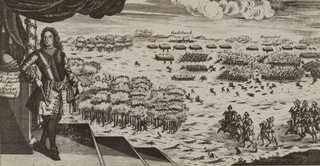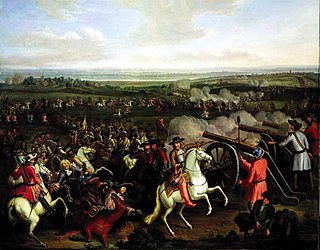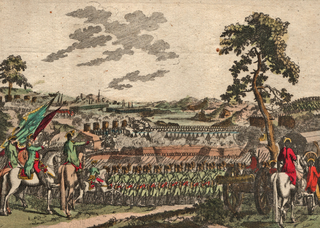
The Battle of Fraustadt was fought on 2 February 1706 (O.S.) / 3 February 1706 / 13 February 1706 (N.S.) between Sweden and Saxony-Poland and their Russian allies near Fraustadt in Poland. During the Battle of Fraustadt on February 3, August II was only 120 km away, with a cavalry force about 8,000 men strong. According to Cathal Nolan that caused Swedish General Rehnskiöld to rush to engage Schulenburg. The Swedes were outnumbered by more than two to one by Saxons, mercenaries, and Russians. Ignoring the odds, Rehnsköld attacked the enemy's well-entrenched position. He sent cavalry to drive off defending Saxon horse on either wing and complete a classic double envelopment. The manoeuvre meant they could attack from behind into the center rear of the enemy's main line. The result was 8,000 Russian deaths and 5,000 Saxons and German mercenaries taken prisoner. The battle is a textbook example of a perfect pincer movement and was one of Sweden's key victories in the Great Northern War.

The Battle of Warsaw took place near Warsaw on July 28–July 30 [O.S. July 18–20] 1656, between the armies of the Polish–Lithuanian Commonwealth and Sweden and Brandenburg. It was a major battle in the Second Northern War between Poland and Sweden in the period 1655–1660, also known as The Deluge. According to Hajo Holborn, it marked "the beginning of Prussian military history".

The Battle of Holowczyn was fought in July 1708 between the Russian army, and the Swedish army, led by Charles XII of Sweden, only 26 years of age at the time. Despite difficult natural obstacles and superior enemy artillery, the Swedes were able to achieve surprise and defeat the numerically superior Russian forces, who were separated from each other, had no overall command and could not coordinate their actions, disallowing them an engagement in full force. Reportedly, it was Charles' favourite victory.

The Battle of Gadebusch or Wakenstädt was Sweden's final great victory in the Great Northern War. It was fought by the Swedes to prevent the loss of the city of Stralsund to Danish and Saxon forces.

The Battle of Fehrbellin was fought on June 18, 1675, between Swedish and Brandenburg-Prussian troops. The Swedes, under Count Waldemar von Wrangel, had invaded and occupied parts of Brandenburg from their possessions in Pomerania, but were repelled by the forces of Frederick William, the Great Elector, under his Feldmarschall Georg von Derfflinger near the town of Fehrbellin. Along with the Battle of Warsaw (1656), Fehrbellin was crucial in establishing the prestige of Frederick William and Brandenburg-Prussia's army.

The Battle of Vyborg Bay was a naval battle fought between Russia and Sweden on 3 July 1790 in Vyborg Bay off the coast of Vyborg during the Russo-Swedish War (1788–1790). The Swedish Navy suffered heavy losses, losing seven ships of the line and three frigates, but Gustav III of Sweden eventually ensured a Swedish naval escape through a Russian naval blockade composed of units of the Baltic Fleet, commanded by Admiral Vasily Chichagov. British historians would later call the Battle of Vyborg Bay the "Baltic Trafalgar". The battle ranks among the world's largest historical naval battles and also among the most influential, as it introduced the naval battle concept of "firepower over mobility".

The Battle of Grengam, Finnish: Flisön taistelu of 1720 was the last major naval battle in the Great Northern War that took place in Åland, in the Ledsund strait between the island communities of Föglö and Lemland. The battle marked the end of Russian and Swedish offensive naval operations in Baltic waters. The Russian fleet conducted one more raid on the Swedish coast in spring 1721, whereupon the Treaty of Nystad was signed, ending the war.

The Battle of Helsingborg was the last major engagement of the Great Northern War to take place on Swedish soil. It resulted in a decisive victory of a Swedish force of 14,000 men under the command of Magnus Stenbock against a Danish force of equal strength under the command of Jørgen Rantzau, ensuring that Denmark's final effort to regain the Scanian territories that it had lost to Sweden in 1658 failed. The battle was fought on March 10, 1710, in the province of Scania, just outside the city of Helsingborg, and directly on the Ringstorp heights just north-east of the city.

The Battle of Napue or the Battle of Storkyro / Isokyrö was fought on 19 February 1714 (O.S.) / 2 March 1714 (N.S.) at the villages of Napue and Laurola in the Isokyrö parish of the Swedish Empire between the Swedish Empire and the Tsardom of Russia. It was the final land battle of the Finnish campaign in the Great Northern War. The Swedish detachment, consisting almost entirely of Finnish troops, were defeated by the numerically superior Russian force. As a result, all of Finland fell under Russian military occupation for the rest of the War; a seven-year period of hardship known in Finland as the Great Wrath.

The invasion of Russia by Charles XII of Sweden was a campaign undertaken during the Great Northern War between Sweden and the allied states of Russia, Poland, and Denmark. The invasion began with Charles's crossing of the Vistula on 1 January 1708, and effectively ended with the Swedish defeat in the Battle of Poltava on 8 July 1709, though Charles continued to pose a military threat to Russia for several years while under the protection of the Ottoman Turks.

The Battle of Pälkäne, sometimes called the Battle at Kostianvirta or Battle on the Pialkiane River was fought between the Russian army under Admiral Fyodor Apraksin and the defending Finnish army of Sweden under General Carl Gustaf Armfeldt on 17 October 1713, as part of the Great Northern War. It resulted in a Russian victory, although General Armfeldt was able to withdraw his army in good order.

The Battle of Frisches Haff or Battle of Stettiner Haff was a naval battle between Sweden and Prussia that took place 10 September 1759 as part of the ongoing Seven Years' War. The battle took place in the Szczecin Lagoon between Neuwarp and Usedom, and is named after an ambiguous earlier name for the Lagoon, Frisches Haff, which later exclusively denoted the Vistula Lagoon.

Baggensstäket is a strait in the Stockholm archipelago, between the island of Värmdö and the mainland (Södermanland).

The Södermanland Regiment, designated P 10 or P 3 and P 10/Fo 43, was an armored regiment of the Swedish Army with its roots in the 17th century, and was located in Strängnäs. The regiment was deactivated in 2004 and its assets were funneled into other parts of the military. Its life company was transferred to the Södermanland Group of the Home Guard, making the Södermanland Group the only Home Guard unit with such a company.

The Battle of Porrassalmi was fought near the bight of Porrassalmi in Savonia on 13 June 1789, during the Russo-Swedish War (1788–90). A Swedish force of about 750 men succeeded in stopping the northbound advance of a Russian force numbering 5,000 men.

The Russian Pillage, is the name for the action of the Imperial Russian Fleet toward the Swedish civilian population along the Swedish east coast, as well as expeditions and the raids of single unit in the inland, during the finishing years of the Great Northern War in 1719–1721.

Events from the year 1708 in Sweden

Hamn was a battlefield museum in Fisksätra, Nacka Municipality, near Stockholm, Sweden about the Battle of Stäket on 13 August 1719 when Russian force, circumventing Vaxholm Castle, attempted to pass through Baggensstäket, a very narrow passage in the Stockholm archipelago. After a desperate counterattack by Södermanlands regemente the Russian force departed. It is debated whether or not this was a Russian attempt to reach Stockholm.

Södermanland Regiment, designation I 10, was a Swedish Army infantry regiment that operated 1634–1942 and 1957–1963. The unit was based in the Strängnäs Garrison in Strängnäs, Södermanland, Sweden. In 1963 the regiment was transferred to the Swedish Armoured Troops under the name of Södermanland Regiment.
The Stockholm Army was an army consisting of 8,000–9,000 troops formed in 1719 in order to defend Sweden's capital city, Stockholm, from Russian attacks during the Great Northern War.


















